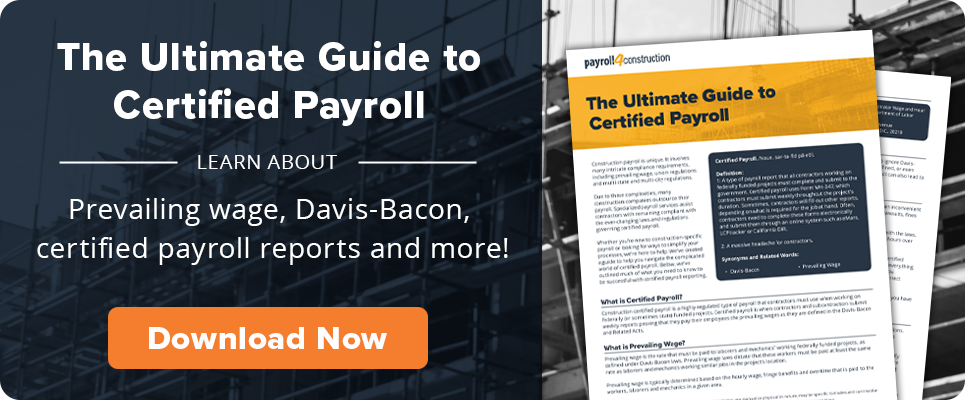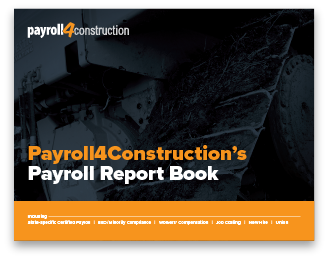
December 19, 2023
The U.S. Department of Labor (USDOL) has officially published its changes to the Davis-Bacon Act and Related Acts (DBRA). Any construction professional working on projects covered by the Davis-Bacon and Related Acts should be aware of these regulatory changes.
We’re here to break down the new changes to the Davis-Bacon regulations and help you take appropriate steps to ensure compliance.
The Background Of Davis-Bacon Act
These alterations mark the first major revisions to the Davis-Bacon Act in over 40 years. These changes officially took effect on October 22, 2023. If a DBRA contract was already underway prior to this date, it is exempt from the changes until the next applicable contract.
The final rule is designed to provide greater clarity on the DBRA regulations. A few major changes include[1]:
- Updated prevailing wage rates which, over time, would mean higher wages for workers.
- Revising the “prevailing wage” definition to ensure prevailing wages reflect actual wages paid to workers in the local community.
- Periodically updating prevailing wage rates to address out-of-date wage determinations.
- Providing broader authority to adopt state or local wage determinations with certain criteria.
- Issuing supplemental rates for key job classifications when no survey data exists.
- Updating regulatory language to reflect modern construction practices.
- Strengthening worker protections and enforcement, including debarment and anti-retaliation provisions.
DBRA regulation changes coincide with the government’s recent investments in the nation’s infrastructure, as the Biden-Harris Administration focuses on improving current environmental conditions per the Investing in America initiative. USDOL estimates tens of billions have been put towards federal and federally assisted construction spending.
It’s anticipated that several new federal investments will support projects related to clean energy, power and water infrastructure improvements, pollution remediation, and transportation infrastructure renovation. Contractors who are able to work those types of jobs should take special note of the new Davis-Bacon changes in case those projects take priority.
Frequently Asked Questions
Who is impacted by Davis-Bacon changes?
The changes to the DBRA apply to all federal contractors and subcontractors performing on projects exceeding $2,000 for the construction, alteration or repair of public buildings or public works.
Will these changes apply to every Davis-Bacon Job?
Yes, these changes will apply to all Davis-Bacon construction contracts issued after October 22nd, 2023.
What changes were made to prevailing wage?
The USDOL re-established the Wage and Hour Division’s (WHD) original methodology for determining prevailing wages, known as the 30% rule.
According to this process, in the absence of a majority wage rate paid to workers in a particular classification, a wage rate will be considered prevailing if it is paid to at least 30% of workers. Only if there is no 30% wage rate will a weighted average rate be used, which will most likely coincide with union rates.
For example, Company A is about to start a federally-funded piping project in Strongsville, Ohio. There currently is no set prevailing wage in that region for pipe installers. To establish an official prevailing wage, according to the “new 30% rule,” the USDOL will review what the current wage rates are for Strongsville pipe installers, and if at least 30% of workers are paid a specific rate, then that is the new prevailing wage. If there is too great a range of rates, then the average is taken.
How will wage updates be determined?
Periodic wage updates will be based on total compensation data from the Bureau of Labor Statistics Employment Cost Index (ECI), which tracks both wages and benefits. Rate updates will occur once every three years at most.
Is there a separation between metropolitan and rural wage rates?
No, the USDOL has decided to eliminate this separation. Because residents of rural counties may work on projects in metropolitan counties, applying other rural counties’ wages could result in a prevailing wage that it is lower than the actual rates.
Will the geographic scope of wage determination expand?
The updates to the DBRA will now require the USDOL to determine prevailing wages “in the civil subdivision of the State in which the work is to be performed.”
Adopting state prevailing wage rates.
Some states have set their own prevailing wage rates using their own methods, which may or may not be compatible with federal wage determinations. The final rule allows the Department of Labor to incorporate certain state wage determinations into the federal survey process so long as four criteria are met[2]:
- The state or local government must set prevailing wage rates and collect relevant data using a survey or other process that generally is open to full participation by all interested parties;
- The state or local wage rate must reflect both a basic hourly rate of pay as well as any locally prevailing bona fide fringe benefits, which can be calculated separately;
- The state or local government must classify laborers and mechanics* in a manner that is recognized within the field of construction; and
- The state or local government’s criteria for setting prevailing wage rates must be substantially similar to those DOL uses for making wage determinations under 29 CFR Part 1.
*Laborers and mechanics are defined as workers whose duties are manual or physical in nature, may be specific to trades, and can involve tools. A more detailed definition can be found at www.laborcompliancegroup.com under 15e Interpretations or in the USDOL’s DBRA Compliance Principles.
How does the revised “site of work” definition affect construction projects?
The “site of work” definition has expanded. According to the new DBRA regulations, labor standards will also apply at a “secondary construction site.” This is defined as any other site where a significant portion of the building or work is constructed. This means that if there is a prevailing wage in effect at Jobsite A, any other place related to Jobsite A that is performing extensive work for Jobsite A must still apply the prevailing wage rates.
The regulations further define a “significant portion” of a building or work to mean one or more entire portions or modules; this does not include materials or prefabricated component parts. A significant portion is defined as “a completed room or structure, with minimal construction work remaining other than the installation and/or final assembly of the portions or modules at the place where the building or work will remain.”[3]
Does this modify the types of projects subject to DBRA?
The final rule expands the types of work covered by DBRA requirements to include the installation of energy equipment (such as solar panels, wind turbines, electric car chargers, etc.) in public buildings or public works. It also recognizes specialized categories of workers not previously considered, such as surveyors.
Has fringe benefit annualization been added to the regulations?
Yes, the DBRA now clarifies the requirement that fringe benefits should be annualized. This annualization requires a contractor working a Davis-Bacon project to spread fringe benefit contributions for a worker across hours worked on all projects, both Davis-Bacon and non-Davis-Bacon. The purpose is to keep contractors from applying fringe benefits for non-Davis-Bacon projects on Davis-Bacon projects.
For example, here is what a laborer’s pay may look like:
Total hours worked for the year: 1,500
Total hours worked on public work: 500
Prevailing wage rate: $20 per hour
The total annual cost of benefits: $15,000 (Medical, dental, pension, etc.)
Annualized hourly credit for benefits: $10 per hour ($15,000 benefit cost/1,500 total hours)
Additional cash wages: $5,000
Did certified payroll reporting change?
Yes and no. The method of submitting certified payroll did not change, however the fringe benefit annualization has been officially formalized on certified payroll reports going forward.
How does the final rule affect apprenticeships?
Contractors and subcontractors must comply with the apprentice wage and ratio standards of the locality where the work is performed.
When are multiple wage determinations incorporated?
If a construction contract includes work in more than one area, then workers will be paid the applicable prevailing wage rate for each area. For example, if a construction project spans across different counties, each with its own prevailing wage rate, the contract should incorporate multiple wage determinations to ensure that workers are paid the correct rate for each specific location.
Multiple wage determinations are also applicable when a project has more than one type of specialization. For example, if a construction project includes both the building of infrastructure and the laying of roads, each of which may have different wage rates, multiple wage determinations are necessary to ensure that employees are compensated in accordance with the prevailing wage rates for each respective type of work.
Did the changes to DBRA increase recordkeeping requirements?
Yes. The DBRA now requires contractors to retain all contracts, subcontracts, bids, proposals, amendments, modifications, and extensions specific to the project, in addition to the already required certified payroll and back-up wage payment information.
Payrolls and other basic records must be kept for at least three years after all the work on the prime contract is completed. Records are required to include each worker’s last known telephone number and email address. Contractors and subcontractors must maintain records of each worker’s correct classification or classifications of work performed and the hours worked in each classification.
How Construction-Specific Payroll Services Can Help
Complying with the revised Davis-Bacon Act can be challenging. The best way to manage these new regulations while also simplifying certified payroll is to invest in a payroll service designed to handle prevailing wage calculations, job classifications, and reporting requirements specific to Davis-Bacon projects.
Construction-specific payroll services can automate prevailing wages so the correct pay rates and fringes default for each employee. A payroll service can also help manage and calculate fringe benefits accurately and in compliance with Davis-Bacon requirements.
Because of the specifics that come with certified payroll, finding a service that is specific to the construction industry is crucial. A construction-specific payroll service, such as Payroll4Construction, has reliable experts with in-depth industry knowledge, information on regulations, and support for issues.
Working on Davis-Bacon jobs requires detailed compliance, but the payroll requirements shouldn’t discourage contractors from bidding. Resources like Payroll4construction are available to help companies handle certified payroll and ensure compliance with the various wage determinations that oversee their jobs.
With the complexities of construction payroll managed automatically, you can make the most out of your Davis-Bacon jobs.
[1] Vaught, G. (2023, August 8). US Department of Labor Announces Final Rule to modernize Davis-Bacon Act. DOL. https://www.dol.gov/newsroom/releases/whd/whd20230808
[2] Frequently asked questions: Updating the davis-bacon and related acts regulations final rule. DOL. (n.d.). https://www.dol.gov/agencies/whd/government-contracts/construction/rulemaking-davis-bacon/faqs
[3] Frequently asked questions: Updating the davis-bacon and related acts regulations final rule. DOL. (n.d.). https://www.dol.gov/agencies/whd/government-contracts/construction/rulemaking-davis-bacon/faqs
Share Article
Keep on current news in the construction industry. Subscribe to free eNews!



